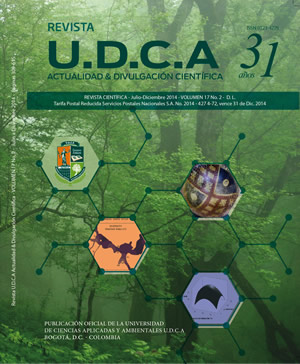Efecto del cambio climático sobre la fisiología de las plantas cultivadas: una revisión
Effect of climate change on the physiology of crop plants: a review
Contenido principal del artículo
Resumen
Para analizar los efectos del cambio climático sobre la fisiología de las plantas es necesario considerar varios factores ambientales y su interacción con los procesos fisiológicos de las plantas. El objetivo de esta revisión fue presentar el conocimiento actual de las investigaciones relacionadas con los efectos del cambio climático sobre la fisiología de las plantas. Se han abordado los efectos del incremento de CO2, temperatura, agua (déficit y exceso hídrico) y ozono, sobre el crecimiento y el desarrollo de varias especies cultivadas. El incremento de la temperatura generará problemas de erosión genética y conducirá a la extinción de muchas especies vegetales; las altas temperaturas pueden afectar adversamente la fotosíntesis, la respiración, las relaciones hídricas y la estabilidad de las membranas, la regulación hormonal y el metabolismo secundario de las plantas. La fotosíntesis neta, se incrementa progresivamente con el aumento del CO2, en particular, en especies C3, pero a altas temperaturas, se reduce por efecto del aumento en la fotorrespiración. La exposición al ozono (O3) disminuye la difusión estomática, la tasa fotosintética, afecta la partición de asimilados y, en general, reduce el crecimiento de las plantas.
Palabras clave:
Descargas
Datos de publicación
Perfil evaluadores/as N/D
Declaraciones de autoría
- Sociedad académica
- Universidad de Ciencias Aplicadas UDCA
- Editorial
- Universidad de Ciencias Aplicadas y Ambientales U.D.C.A
Detalles del artículo
Referencias (VER)
AGBICODO, E.M.; FATOKUN, C.A.; MURANAKA, S.; VISSER, R.G.F.; LINDEN VAN DER, C.G. 2009. Breeding drought tolerant cowpea: constraints, accomplishments, and future prospects. Euphytica (Holanda). 167(3):353-370.
ASHLEY, J. 1993. Drought and crop adaptation. In: Rowland, J.R.J. (ed) Dryland farming in Africa. Macmillan Press Ltd, UK. p.46-67.
BALE, J.S.; MASTERS, G.J.; HODKINSON, I.D.; AWMACK, C.; BEZEMER, T.M.; BROWN, V.K.; BUTTERFIELD, J.; BUSE, A.; COULSON, J.C.; FARRAR, J.; GOOD, J.E.G.; HARRINGTON, R.; HARLEY, S.; JONES, T.H.; LINDROTH, R.L.; PRESS, M.C.; SYMRNIOUDIS, I.; WATT, A.D.; WHITTAKER, J.B. 2002. Herbivory in global climate change research: direct effects of rising temperature on insect herbivores. Global Change Biol.(Inglaterra). 8(1):1-16.
BRUNELE, F.; DA SILVA, D.; PEDROSA, D.; CARDOSO,T.; PUGNAL, A. 2009. Enriquecimento intermitente de CO2 e análise do acúmulo de massa seca e da partição de fotoasimilados em tomateiro. Acta Agr. (Colombia). 58(3):133-139.
CALVERT, A.; SLACK, G. 1975. Effects of Carbon dioxide enrichment on growth, development and yield of glasshouse tomatoes.Responses to controlled concentrations. Hort. Sci. (Estados Unidos). 50(1):61-71.
CAMBIO CLIMÁTICO GLOBAL.COM. 1997. Lista resumen sobre gases invernadero. Disponible desde Internet en http://www.cambioclimaticoglobal.com/ gasesinv (con acceso 26/03/2011).
CARTER, A.K.; VAVRINA, CH. S. 2001. High Temperature inhibits germination of jalapeño and cayenne Pepper. Hort. Sci. 36(4):724-725.
CASTAGNA, A.; NALI, S.; CIOMPI, G.; LORENZINI, G.; SOLDATINI, F.; RANIERI, A. 2001. Ozone exposure affects photosynthesis of pumpkin (Cucurbita pepo) plants. New Phytologist (Inglaterra). 152(2):223-229.
CONROY, J.P.; SENEWEERA, S.; BASRA, A.S.; ROGERSAND, G.; NISSEN, B. 1994. Influence of rising atmospheric CO2 concentrations and temperature on growth, yield and grain quality of cereal crops. Aus. J. Plant Physiol. 21(6):741-758.
COOLEY, D.; MANNING, W.J. 1987.The impact of ozone on assimilate partitioning in plants: A review. Environm. Poll. (EstadosUnidos). 47(2):95-113.
CRAUFURD, P.Q.; PRASAD, P.V.V.; KAKANI, V.G.; WHEELER, T.R.; NIGAM, S.N. 2003. Heat tolerance in groundnut. Field Crops Res. (Estados Unidos). 80(1):63-77.
CHALLINOR, A.J.; WHEELLER, T.R.; CRAUFURD, P.Q.; FERRO, C.A.T.; STEPHENSON, D.B. 2007. Adaptation of crops to climate change through genotypic responses to mean and extreme temperatures. Agr., Ecosyst. Environm. (Estados Unidos). 119(1-2):190-204.
CHMIELEWSKI, F.M.; RÖTZER, T. 2001. Response of tree phenology to climate change across. Europ. Agr. Forest Meteorology (Canadá). 108(1):101-112.
CHMIELEWSKI, F.M.; MÜLLER, A.; BRUNS, E. 2004. Climate changes and trends in phenology of fruit trees and field crops in Germany, 1961-2000. Agr. Forest Met.121(1):69-78.
DEEP, F. 2003. Enfoques conceptuales y sistemas de información sobre seguridad alimentaria. Ponencia realizada para el seminario de políticas de seguridad alimentaria y nutrición en América Latina. FODEPAL, Campinas (Brasil), 13p.
DERMODY, O.; O?NEILL, B.F.; ZANGERL, A.R.; BERENBAUM, M.R.; DELUCIA, E.H. 2008. Effects of elevated CO2 and O-3 on leaf damage and insect abundance in a soybean agroecosystem. Arthropod-Plant Interactions (Finlandia). 2(3):125-135.
ECHARRI, P.L. 2011. Ciencias de la Tierra y del Medio Ambiente. Libro electrónico.2011. Disponible desde Internet en: http://www.tecnun.es/asignaturas/ecologia/ (con acceso 26/03/11).
EEI (Estación Espacial Internacional). 1997. La convención marco sobre cambio climático Introducción. Disponible desde Internet en: http://www.cambioclimaticoglobal. com (con acceso 24/03/11).
ELIZALDE, A. 2009. ¿Qué desarrollo puede llamarse sostenible en el siglo XXI? Universidad Bolivariana Santiago de Chile. Revista de Educación. Número extraordinario. p.53-75. Disponible desde Internet en: http://www.revistaeducacion.mec.es. (con acceso 26/07/2011).
EPHRATH, J.; TIMLIN, D.J.; BAKER, J.T.; REDDY, V. 2001. Effects of elevated CO2 concentration and water stress on the root to shoot ratio of cotton. Abstract of ASA-CSSA-SSSA International Annual Meeting. Disponible desde Internet en: http://cottondb.org/ cgi-bin/ace/tree/cottondb?name=ACS-2001-c02- ephrath080054-P&class=Reference (con acceso 26/07/2011).
FELLER, U.; CRAFTS-BRANDNER, S.; SALVUCCI, Y.M. 1998. Moderately high temperatures inhibit ribulose-1,5-bisphosphate carboxylase/oxygenase (rubisco) activase-mediated activation of Rubisco. Plant Physiol. (Estados Unidos). 116(2):539-546.
GAY, C.; CONDE, C. 2004. El cambio climático y el café. Bol. Inform. El Faro. UNAM. p.8-9.
GCCIP (Global Climate Change Information Programme). 1997. La convención marco sobre cambio climático. El presupuesto energético de la atmósfera. Disponible desde Internet en: http://www. cambioclimaticoglobal.com/presupue.html (con acceso 25/03/11).
GHANNOUM, O.; VON CAEMMERER, S.; ZISKA, L.H.; CONROY, J.P. 2000. The growth response of C4 plants to rising atmosphericCO2 partial pressure: a reassessment. Plant, Cell Environm. (Estados Unidos). 23(9):93-942.
GRANTZ D.; FARRAR, J. 1999. Acute exposure to ozone inhibits rapid carbon translocation from source leaves of Pima cotton. J. Experim. Botany (Reino Unido). 50(336):1253-1262.
GRANTZ, D.; YANG, S. 1996. Effect of O3 on hydraulic architecture in Pima cotton (biomass allocation and water transport capacity of roots and shoots). Plant Phys. 112(4):1649-1657.
GRANTZ, D.; SILVA, V.; TOYOTA, M.; OTT, N. 2003. Ozone increases root respiration but decreases leaf CO2 assimilation in cotton and melon. J. Exp. Botany. 54(391):2375-2384.
HALL, A.E.; CISSE, N.; THIAW, S.; ELAWAD, H.O.A.; EHLERS, J.D.; ISMAIL, A.M.; FERY, R.; ROBERTS, P.A.; KITCH, L.W.; MURDOCK, L.L.; BOUKAR, O.; PHILLIPS, R.D.; MCWATTERS, K.H. 2003. Development of cowpea cultivars and germplasm by the Bean/Cowpea CRSP. Field Crops Res. 82:103-134.
HANSEN, J.; SATO, M.; NAZARENKO, L.; RUEDY, R.; LACIS, A.; KOCH, D.; TEGEN, I.; HALL, T.; SHINDELL,D.; STONE, P.; NOVAKOV, T.; THOMASON, L.; WANG, R.; WANG,Y.; JACOB, D.J.; HOLLANDSWORTH-FRITH, S.; BISHOP, L.; LOGAN, J.; THOMPSON, A.; STOLARSKI, R.; LEAN, J.; WILLSON, R.; LEVITUS, S.; ANTONOV, J.; RAYNER, N.; PARKER, D.; CHRISTY, J. 2002. Climate forcings in the Goddard Institute for Space Studies SI2000 simulations. J. Geophys. Res. (Estados Unidos). 107(D18):4347-4384.
HANSON, P.M.; CHEN, J.; KUO, G. 2002. Gene action and heritability of high temperature fruit set in tomato line CL5915. Hort Sci. 37(1):172-175.
HOUGHTON, D. 1985. Handbook of Applied Meteorology. John Wiley & Sons. New York, Chapter 40. Environmental impacts. I. Van der Hoven. p.1147- 1163. Disponible desde Internet en: http://www. mma.es (con acceso 23/03/2011).
HUNT, B.G.; ELLIOTT, T. 2002. Mexican mega drought. Climate Dynamics (Alemania). 20(1):1-12.
IDEAM (Instituto de Hidrología, Meteorología y Estudios Ambientales, CO). 2009. Los fenómenos el niño / la niña. Disponible desde Internet en: http://www. ideam.gov.co (con acceso 23/03/2011).
IPCC (Intergovernmental Panel of Climate Change). 2001. Climate Change 2001: Volume II Impacts, Adaptation and Vulnerability, Cambridge University Press. 397p.
IPCC (Intergovernmental Panel of Climate Change). 2004. Describing Scientific Uncertainties in Climate Change to Support Analysis of Risk and of Options. Disponible desde Internet en: http://www.ipcc.ch/pdf/ supporting-material/ipcc-workshop-2004-may.pdf (con acceso 25/03/2010).
IPCC (Intergovernmental Panel of Climate Change). 2007. Climate change 2007: Synthesis report. Summary for policymakers. Disponible desde Internet en: http://www.ipcc.ch. (con acceso 25/03/11).
IZAURRALDE, R.C.; ROSENBERG, N.J.; BROWN, R.A.; THOMSON, A.M. 2003. Integrated assessment of Hadley Center (HadCM2) climate-change impacts on agricultural productivity and irrigation water supply in the conterminous United States Part II. Regional agricultural production in 2030 and 2095. Agr. Forest Meteorology.117(1-2):97-122.
JARVIS, A.; LANE, A.; HIJMANS, R. 2008. The effect of climate change on crop wild relatives. Agr., Ecosyst. Environm. 126(1):13-23.
JIMÉNEZ L., T.; MORALES A., T.; REYNA T., V.; HERNÁNDEZ M., S.; OROZCO, F.; LEDESMA G., J. 2004. Dinámica de la sequía intra-estival en el estado de Tlaxcala, México". III Seminario Latinoamericano de Geografía Física, 28 abril- 2 mayo. (CDROM). Puerto Vallaría, Jalisco, México, memorias del evento. p.52-64.
KIM, S.H.; GITZ, D.C.; SICHER, R.C.; BAKER, J.T.; TIMLIN, D.J.; REDDY, V.R. 2007. Temperature dependence of growth, development, and photosynthesis in maize under elevated CO2. Environm. Exp. Botany. 61(3):224-236.
KREUZWIESER, J.; HAUBERG, J.; HOWELL, K.; CARROLL, A.; RENNENBERG, H.; MILLAR, H.; WHELAN, J. 2009. Differential response of gray poplar leaves and roots underpins stress adaptation during hypoxia. Plant Physiol. 149(1):461-473.
KUBIEN, D.; VON CAEMMERER, S.; FURBANK, R.; SAGE, R. 2003. C4 photosynthesis at low temperature. A study using transgenic plants with reduced amounts of Rubisco. Plant Physiol. 132(3):1577-1585.
LAU, CH.; JARVIS, A.; RAMÍREZ, J. 2011. Agricultura Colombiana: Adaptación al Cambio Climático. Centro Internacional de Agricultura Tropical (CIAT). 4p.
LU, YAO-CHI. 2005. An Economic Analysis of Climate Change on Cotton Production Across the U.S. Cotton Belt. Disponible desde Internet en: http://www. ars.usda.gov/research/publications/Publications. (con acceso 06/10/2005).
MCGAO. 2001. La simulación del sistema climático y sus cambios. Disponible desde Internet en: http://www. grida.no/climate/ipcc_tar (con acceso 23/03/2011).
MCKEOWN, A.; WARLAND, J.; MCDONALD, M.R. 2005. Long-term marketable yields of horticultural crops in southern Ontario in relation to seasonal climate. Can. J. Plant Sci. 85(2):431-438.
MERA, R.J.; NIYOGI, D.; BUOL, G.; WILKERSON, G.; SEMAZZI, F. 2006. Potential individual versus simultaneous climate change effects on soybean (C3) and maize (C4) crops: An agrotechnology model based study. Global and Planetary Change (Reino Unido). 54(1-2):163-182.
MILLER, C.; DAVIS, D. 1981. Effect of temperature on stomatal conductance and ozone injury of pinto bean leaves. Plant Disease. 65(9):750-751.
MITRA, J. 2001. Genetics and genetic improvement of drought resistance of crop plants. Current Sci. (India). 80(6):758-763.
MÜLLER, C.; BONDEAU, A.; POPP, A.; WAHA, K.; FADER, M. 2010. Climate change impacts on agricultural yields. Background note to the World Development Report 2010. Potsdam Institute for Climate Impact Research, Potsdam.12p. Disponible desde Internet en: http://www.pik-potsdam.de/research (con acceso 28/08/2011).
NASA (NATIONAL AERONAUTICS AND SPACE ADMINISTRATION). 2001. Cotton doesn?t shrink from climate change. Disponible desde Internet en: http://www.gsfc.nasa.gov/news-release/ releases/2001/01-118.htm (con acceso 06/10/2005).
NASCIMENTO, W.M.; CANTLIFFE, D.J.; HUBER, D.J. 2000. Thermotolerance in lettuce seeds: Association with ethylene and endo-β-mannanase. J. Amer. Soc. Hort. Sci.125 (4):518-524.
NELSON, C.; ROSEGRANT, M.; KOO, J.; ROBERTSON, R.; SULSER, T.; ZHU, T., RINGLER, C.; MSANGI, S.; PALAZO, A., BATKA, M., MAGALHAES, M.; VALMONTE-SANTOS, R.; EWING, M., LEE, D. 2009. Cambio climático: el impacto en la agricultura y los costos de adaptación. Instituto Internacional de Investigación sobre políticas alimentarias IPFRI. 30p. Disponible desde Internet en: http://www.fao.org. (con acceso 10/08/2010).
NRDC (Natural Resources Defense Council). 2008. La onda verde; Datos principales sobre el calentamiento global. Disponible desde Internet en: http://www. nrdc.org/laondaverde/globa (con acceso 21/03/ 2011).
OLESEN, J.E.; TRNKAB, M.; KERSEBAUMC, K.C.; SKJELVAGD, A.O.; SEGUINE, B.; PELTONENSAINIOF, P.; ROSSIG,F.; KOZYRAH, J.; MICALEI, F. 2011. Impacts and adaptation of European crop production systems to climate change. Europ. J. Agron. (Francia). 34(1):96-112.
ORESKES, N. 2004. Beyond the Ivory Tower. The Scientific Cosensus on Climatic Change. Science. 306(5702):1686.
OSBORN, T.J.; BRIFFA, K.R. 2005.The spatial extent of 20th-century warmth in the context of the past 1200 years. Science. 311(5762):841-844.
PARRY, M.L.; ROSENZWEIG, C.; IGLESIAS, A.; LIVERMORE, M.; FISCHER, G. 2004. Effects of climate change on global food production under SRES emissions and socioeconomic scenarios. Global Environm. Change (ReinoUnido).14(1):53-67.
PEARCY, R.W.; EHLERINGER, J. 1984. Comparative ecophysiology of C3 and C4 plants. Plant, Cell Environm. 7(1):1-13.
POMPELLI, M.; BARATA, R.; VITORINO, H.; GONÇALVES, E.; ROLIM, E.; SANTOS, M.; ALMEIDA, J.; FERREIRA, V.; LEMOS, E.; ENDRES, L. 2010. Photosynthesis, photoprotection and antioxidant activity of purging nut under drought deficit and recovery. Biomass Bioenergy (ReinoUnido). 34(8):1207-1215.
REDDY, K.; HODGES, H. 2005. Impacts of climate change on cotton production: a Southcentral assessment. Disponible desde Internet en: http://nigec. ucdavis.edu/ (con acceso el 06/10/2005).
REDDY, K.; HODGES, H.F.; MCKINION, J.M. 1997. Water and nutrient deficits, crop yields and climate change. World Resource Rev. (Estados Unidos). 10(1):23-43.
REDDY, K.; REDDY, R.; HODGES, H.F. 1998. Interactive effects of elevated carbon dioxide and growth temperature on photosynthesis in cotton leaves. Plant Growth Reg. Surafrica). 26(1):33-40.
REDDY, V.; PACHEPSKY, Y.Y. 2002. Temperature effects on node development rates in cotton. Ann. Botany (EstadosUnidos). 31:101-111.
RIKIN, A.; DILLWITH, J.W.; BERGMAN, D.K. 1993. Correlation between the circadian rhythm of resistance to extreme temperatures and changes in fatty acid composition in cotton seedlings. Plant Physiol. 101(1):31-36.
ROUDIER, P.; SULTAN, B.; QUIRION, P.; BERG, A. 2011.The impact of future climate change on West African crop yields: What does the recent literature say? Global Environm. Change. 21(3):1073-1083.
SCHLENKER, W.; LOBELL, D.B. 2010. Robust negative impacts of climate change on African agriculture. Environm. Res. Letters (Reino Unido). 5(1):1-8.
SCHNELLHUBER, H. 2008. Global warming: Stop worrying, start panicking? PNAS (Estados Unidos). 105(38):14239-14240.
SCHÖFFL, F.; PRANDL, R.; REINDL, A. 1999. Molecular responses to heat stress. In: Shinozaki, K., Yamaguchi- Shinozaki, K. (Eds.). Molecular Responses to Cold, Drought, Heat and Salt Stress in Higher Plants. R.G. Landes Co., Austin, Texas, p.81.98.
SHAO, G.; HALPIN, P.N. 1995. Climatic controls of eastern North American coastal tree and shrub distributions. J. Biogeography (Estados Unidos). 22 (6):1083-1089.
SILVA, A.C.; LEITE, I.C.; BRAZ, L.T. 2000. Avaliação da viabilidade do pólen como possível indicativo de tolerância a altas temperaturas em genótipos de tomateiro. Rev. Bras. Fisiol. Vegetal.12(2):156-165.
SOTO, W. 2009. La teoría de la sociedad del riesgo global: ¿es capaz de dar cuenta del acontecer mundial actual? Bol. Observatorio Política Exterior (Costa Rica). 3(11):8-12.
STAINFORTH, D.; AINA, T.; CHRISTENSEN, C.; COLLINS, M.; FAULL, N.; FRAME, D.; KETTLEBOROUGH J.; KNIGHT, S.; MARTI, A.; MURPHY, J.; PIANI, C.; SEXTON, D., SMITH, L.; SPICER, R.; THORPE, A.; ALLEN, M. 2005. Uncertainty in predictions of the climate response to rising levels of greenhouse gases. Nature:433 (7024):403-406.
STOCK, W.D.; LUDWIG, F.; MORROW, C.D.; MIDGLE, G.F.; WAND, S.J.E.; ALLSOPP, N.; BELL, T.L..2005. Long-term effects of elevated atmospheric CO2 on species composition and productivity of a southern African C4 dominated grassland in the vicinity of a CO2 exhalation. Plant Ecol. (Australia).178(2):211-224.
SUNKAR, R. 2010. Plant Stress Tolerance.Methods and Protocols. Oklahoma state University USA. Humana Press. 401p.
SVENSMARK, H. 2007. Cosmoclimatology: a new theory emerges. Astronomy & Geophysics (Reino Unido). 48(1):18-24.
TAUB, D.R.; MILLER, B.; ALLEN, H. 2008. Effects of elevated CO2 on the protein concentration of food crops: a meta-analysis. Global Change Biol. 14(3):565-575.
THOMAS, C.D.; CAMERON, A.; GREEN, R.E.; BAKKENES, M.; BEAUMONT, L.J.; COLLINGHAM, Y.C.; ERASMUS, B.F.N.; FERREIRA DE SIQEIRA, M.; GRAINGER, A.; HANNAH, L.; HUGHES, L.; HUNTLEY, B.; VAN JAARSVELD, A.S.; MIDGLEY, G.F.; MILES, L.; ORTEGA-HUERTAS, M.A.; PETERSON, A.T.; PHILLIPS, O.L.; WILLIAMS, S.E. 2004. Extinction risk from climate change. Nature. 427(6970):145-148.
TUBIELLO, F.N.; JAMTHOR, J.S.; BOOTE, K.J.; DONATELLI, M.; EASTERLING, W.; FISCHER, G.; GIFFORD, R.M.; HOWDEN, M.; REILLY, J.; ROSENZWEIG, C. 2007a. Crop response to elevated CO2 and world food supply - A comment on "Food for Thought..." by Long et al., Science. 312:1918-1921, 2006. Europ. J. Agron. 26(3):215-223.
TUBIELLO, F.N.; SOUSSANA, J.F.; HOWDEN, S.M. 2007b. Crop and pasture response to climate change.PNAS.Disponible desde internet en: http://www.pnas.org/cgl/ddl/10.1073/pnas.0701728104.
VAN DUIVENBOODEN, N.; ABDOUSSALAM, S.; MOHAMED, A.B. 2002. Impact of climate change on agricultural production in the Sahel-Part 2. Case study for groundnut and cowpea in Niger. Climatic Change 54(3):349-368.
WAHID, A.; GELANI, S.; ASHRAF, M.; FOOLAD, M.R. 2007. Heat tolerance in plants: An overview. Environm. Exp. Botany. 61(3):199-223.
WATSON, R. 2001. Evaluación del Grupo Intergubernamental de Expertos sobre el Cambio Climático (IPCC). Disponible desde Internet en: http://www. ipcc.ch/pub/un/syrspanish/spm.pdf (con acceso 24/03/2011).
WAYNE, H. 2002. Implications of atmospheric and climatic change for crop yield and water use efficiency. Crop Sci.(Estados Unidos). 42(1):131- 140.
WITTIG, R.; KÖNIG, K.; SCHMIDT, M.; SZARZYNSKI, J. 2007. A study of climate change and anthropogenic impacts in West Africa. Environm. Sci. Poll. Res. 14(3):182-189.
YONG, J.; WONG, CH.; LETHAM, D.; HOCART, CH.; FARQUHAR, G. 2000. Effects of elevated [CO2] and nitrogen nutrition on cytokinins in the xylem sap and leaves of cotton. Plant Physiol. (Estados Unidos). 124(2):767-780.
ZAVALA, J.A.; CASTEEL, C.L.; DELUCIA, E.H.; BERENBAUM, M.R. 2008. Anthropogenic increase in carbon dioxide compromises plant defense against invasive insects. Proc. Nal Acad. Sci. 105:5129-5133.







